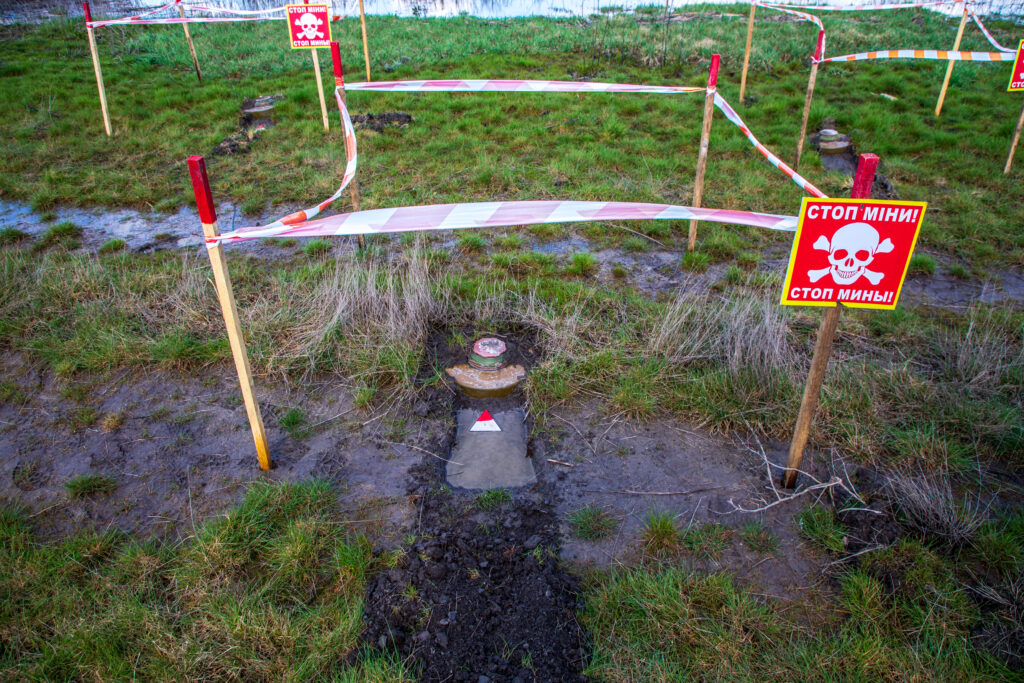Demining Ukraine: the challenges of making land safe in an ongoing war
Article provided by

August 2023
As the war in Ukraine continues unabated, there is one issue which dominates the global headlines: landmines. Before Putin’s troops invaded on 24th February 2022, it was generally accepted that the landmine was becoming a welcome relic of the twentieth century. The Anti-Personnel Mine Ban Convention is regarded as one of the most successful instruments of international humanitarian law and, since its ratification in 1998, the use of landmines in conflict had been steadily declining. For organisations such as The HALO Trust, the world’s largest and oldest mine clearance NGO, the focus was on helping countries such as Cambodia, Angola, Zimbabwe and Sri Lanka confine the weapon permanently to their history books.
The war in Ukraine has changed all that.

The HALO Trust had established a headquarters in Ukraine back in 2015, to tackle the enormous amount of anti-tank mines on the Contact Line that zig-zagged along the Donbas following the Russian annexation of the Crimea and the 2014-15 conflict. It had 450 Ukrainian deminers—women and men—trained by HALO out of the Eastern city of Kramatorsk, with smaller outposts in Mariupol and Shyrokyi. In addition to clearing the anti-tank mines, they also delivered awareness-raising sessions to local communities, warning them of the dangers of handling explosives left from the fighting.
The latest iteration of the war has been far more deadly. Within weeks of the invasion, HALO realised that it had to rapidly expand its personnel and equipment and relocate to central Ukraine to tackle the deadly legacy of the Spring 2022 Russian occupation. It was a herculean effort, but by May 2022, HALO’s deminers were on the ground, clearing mines and ordnance from near Bucha and Chernihiv, with a new headquarters established in Brovary, a city forty minutes east of Kyiv.
Since then, HALO has trained hundreds of new deminers from all over Ukraine. They come from all walks of life—hairdressers, maths teachers, musicians—but all share a common goal: to clear the legacy of fighting in order to protect Ukrainian lives and get the country’s grain economy back on its feet.

There is no doubt that this will be one of the greatest challenges HALO has ever undertaken. The Ukrainian authorities estimate that around 30 per cent of Ukraine’s territory is contaminated, including 1000 km of frontline. While some of that mine laying is systematic, HALO is seeing many varieties of mines and munitions being deployed—the TM-62 anti-tank mine, air-dropped mines such as the PFM-1, also known as ‘the butterfly mine,’ and sensory mines, the POM-3, that can detect the presence of a human remotely. Open-source satellite images indicate that the defensive frontline could be one of the most densely laid minefields the world as ever seen—including the K5 minebelt that runs along the Cambodia/Thai border that HALO has been clearing for 30 years. This is in addition to extraordinarily high amounts of unexploded artillery left by intense shelling.
Meeting the challenge of clearing contamination as dense and complex as this is going to take enormous resources. It will involve pioneering new large mechanical assets and robotic devices and the recruitment of around 10,000 men and women if mine clearance organisations such as HALO are to meet the Ukrainian government’s ambition of clearing most mined areas within 10 years. It will also require governments, private business and philanthropists worldwide to invest millions over a multi-year period.
However, it is imperative to note that HALO is responding now: it does not have to wait for the end of the war. Its teams are clearing landmines from places that were liberated earlier this year, around Kharkiv and Mykolaiv.

HALO’s operations in Ukraine involve three core activities: training, survey and clearance. Training is intense and rigorous: there is a clear pass/fail distinction. The second stage is to send teams out to interview local residents and authorities about where they have seen landmines or witnessed accidents and use that information, alongside open-source intelligence to prioritise a working area, known as a polygon. This enables teams to understand the type of suspected contamination, as well as the quantity and likely positions of it. Since the start of the conflict, HALO has tracked, using open-source information, more than 2,300 incidents in Ukraine in which ordnance requiring clearance was discovered which gives an indication of the scale of the task ahead. (This doesn’t even include results of our on-the ground survey work.)
The humanitarian need is stark. Villages and families have found themselves on the frontline of the war for months on end. Hrakove, in Kharkiv is just one example. Occupied from February 2022 to September, of the original 750 residents, only 47 remained by the time of liberation, the rest forced to flee. Families are desperate to return home, but the village is unrecognisable—homes and streets destroyed and mines and explosives scattered everywhere. Five accidents have already been reported. HALO’s survey teams began work here in November 2022, assessing and marking the mines and explosives, prioritising areas for clearance which started in May 2023.
“In front of my yard there were around 50-60 mines. The end of the street was mined too. It was scary to even walk around. Tripwires were in my neighbour’s yard.”
Viktor, age 63, life-long resident of Hrakove village.
Prior to the 2022 invasion, Ukraine was known as the breadbasket of Europe. The country was one of the world’s top five exporters of sunflower, barley, rapeseed, corn and wheat and the share of agricultural in Ukraine’s GDP was around 20 per cent, with export values totalling $27.8 billion annually.1 But landmines and unexploded ordnance have changed the very landscape, preventing agricultural production that is not just vital for Ukraine’s economy, but for regional and global food security. Since February 2022, the agricultural sector has suffered $8.7 billion2 losses in direct damage. Demining is not only a humanitarian imperative, it is vital for the long-term sustainable recovery of Ukraine and its economy. It is extremely rigorous work that demands extraordinarily high levels of concentration and discipline, which is the hallmark of HALO’s 12,000 global staff working in 30 different countries.
To learn more about the work of The HALO Trust visit: www.halotrust.org
1. Centre for Strategic and International Studies: https://www.csis.org/analysis/russia-ukraine-and-global-food-security-one-year-assessment
2. Data as of May 26, 2023. Source: Kyiv School of Economics: https://kse.ua/about-the-school/news/the-damage-to-ukraine-s-agricultural-sector-and-land-resources-in-the-event-of-a-full-scale-war-amounted-to-8-7-billion/

